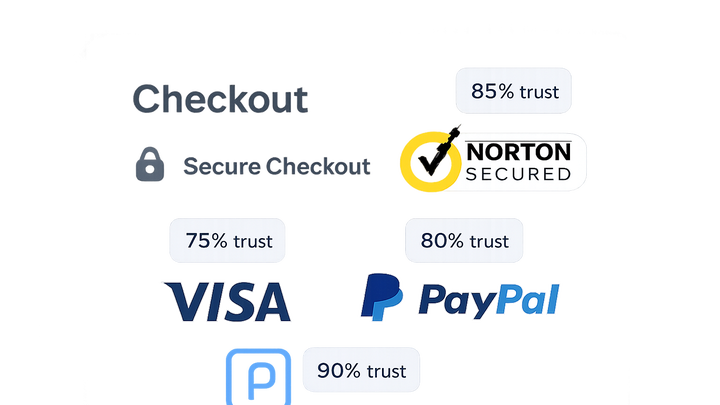Published on 2025-06-29T21:30:51Z
What Is a Secure Checkout Badge? Examples and Best Practices
Secure Checkout Badges are visual indicators—such as SSL lock icons, third-party trust seals, or payment processor logos—that reassure customers their data is protected during checkout. By prominently displaying these symbols, businesses can reduce purchase anxiety and boost conversion rates. From a UX perspective, badges enhance perceived credibility, while from a CRO standpoint they address trust concerns that often lead to cart abandonment. SEO indirectly benefits too, as lower bounce rates and higher engagement signal positive user experience to search engines.
Examples of common badges include:
- SSL/TLS lock icons
- Norton Secured and McAfee Secure seals
- Visa, Mastercard, and PayPal Verified logos
<div class="checkout-badges">
<img src="ssl-lock.svg" alt="SSL Secure">
<img src="norton-seal.svg" alt="Norton Secured">
<img src="visa-logo.svg" alt="Visa Secure">
</div>
Using Prevue.me, you can get actionable critiques on badge placement, clarity, and accessibility to maximize trust and drive more completed checkouts.
Secure checkout badges
Trust seals on e-commerce checkout pages that signal data security, boosting user confidence and conversion rates.
Importance in CRO, UX, and SEO
Secure checkout badges play a critical role across multiple disciplines:
- CRO (Conversion Rate Optimization): They reduce cart abandonment by alleviating security concerns.
- UX (User Experience): They enhance credibility and foster a seamless, reassuring purchase flow.
- SEO (Search Engine Optimization): Improved engagement metrics (lower bounce, higher time on page) signal quality to search engines.
-
Building trust
Badges serve as instant visual proof that the site is secure, helping to overcome skepticism and build buyer confidence.
-
Enhancing user experience
A clear security indicator reduces anxiety and friction during checkout, making the process feel safer and more intuitive.
-
Seo benefits
Websites that retain visitors and complete more transactions often see indirect SEO gains through improved engagement signals.
Common Types of Secure Checkout Badges
Different badges fall into three main categories, each conveying a specific layer of protection or endorsement.
-
Ssl/tls certificate badges
Automatically generated by your SSL provider to indicate encrypted data transfer between browser and server.
-
Third-party trust seals
Issued by security auditors or consumer organizations to certify ongoing site safety and privacy practices.
- Norton secured:
A seal from Symantec that verifies malware-free status and vulnerability assessments.
- Mcafee secure:
Monitors for malicious activity and certifies that the site meets basic security hygiene standards.
- Bbb accredited business:
Signals membership in the Better Business Bureau and adherence to ethical business practices.
- Norton secured:
-
Payment processor logos
Recognition badges from major payment networks reassure customers of secure transaction handling.
- Visa and mastercard:
Widely recognized logos that imply adherence to strict payment data standards.
- Paypal verified:
Indicates the merchant has a verified PayPal account, adding an extra layer of buyer protection.
- American express:
A trusted brand mark that signals strong fraud prevention protocols.
- Visa and mastercard:
Best Practices for Implementation
To maximize the impact of secure checkout badges, follow these guidelines:
-
Strategic placement
Position badges where users naturally look during checkout—near form fields or the final purchase button.
- Above the fold:
Ensure badges are visible without requiring scrolling, especially on mobile devices.
- Near checkout buttons:
Place seals adjacent to the ‘Buy Now’ or ‘Place Order’ buttons for maximum reassurance at the point of decision.
- Above the fold:
-
Consistent design
Use badges that match your site’s color palette and style to avoid visual discord and maintain brand cohesion.
-
Performance optimization
Optimize badge images for fast loading; avoid large files or synchronous scripts that can slow the checkout flow.
Using Prevue.me for Continuous Improvement
Leverage prevue.me’s CRO, UX, SEO, and accessibility critiques to refine your badge strategy over time.
-
Actionable critiques
prevue.me analyzes your checkout flow and provides targeted feedback on badge clarity, placement, and trust effectiveness.
- Badge visibility:
Evaluate if badges are prominent enough across different device viewports.
- Clarity of messaging:
Assess whether badge alt text and tooltips convey meaningful security information.
- Accessibility compliance:
Ensure badges are announced by screen readers and meet contrast requirements.
- Badge visibility:
-
Monitoring and a/b testing
Integrate prevue.me feedback into your A/B tests to continuously optimize badge types, placements, and designs.
